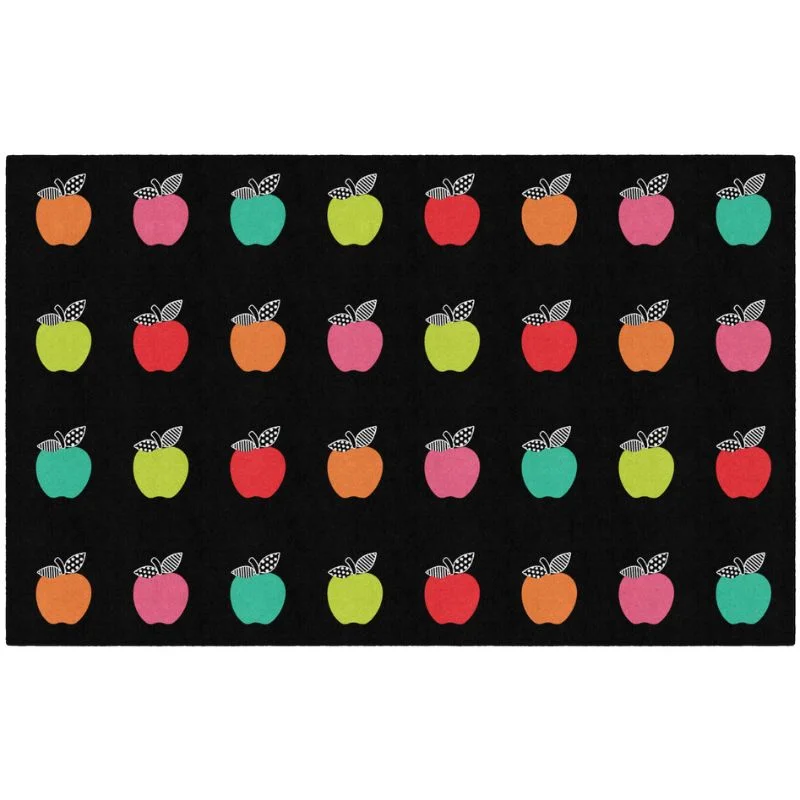Bring a slice of healthy fun to your classroom
Make your classroom pop with the Colorful Apples Sitting Spot Rug. With vibrant colors and a playful design featuring healthy fruits, this rug will make learning fun for students of all ages. Not only is it student friendly, but its fiber density ensures that it can withstand the wear and tear of everyday use.
Please measure your area and choose the right size
Sizes: 5' x 7'6 and 7'6 x 12'
If you love teaching children about healthy food, then the Colorful Apples Sitting Spot Rug is perfect for your classroom. Children will flock to this carpet during playtime, quiet time and lessons. An apple a day keeps the children at play.
- The Colorful Apples Sitting Spot Rug is a perfect classroom rug that promotes healthy food habits among students with its vibrant apple design
- Its high fiber density and infusion dye process, along with antimicrobial and antistatic treatment, make it a student friendly choice for any educational setting
Classroom rugs are an added benefit to those who need their students to sit on the floor to do their work. Adds warmth to any floor and makes learning environments as student friendly as possible.
- Made in the U.S.A.
- Highest fiber density, with an infusion dye process. Ensures bright lasting color.
- Anti-Microbial and Anti-Static Treatment: Guards against odor, mildew and mold.
- Treated with Scotchgard protector for superior soil resistance.
- Class I Flammability Rating and Indoor Air Quality passed.
- 24 oz Nylon w/Urethane Backing System
SensoryEdge is an Authorized Seller of SchoolGirl Style Designs
Apples have a rich and varied history that dates back thousands of years. Here is an overview of the history of apples:
Ancient Beginnings
- Origins: Apples are believed to have originated in the mountainous regions of Central Asia, particularly in what is now Kazakhstan. The wild ancestor of the domestic apple, Malus sieversii, still grows there today.
- Spread: From Central Asia, apples spread along ancient trade routes to the Middle East and Europe. They were cultivated by ancient civilizations such as the Greeks and Romans.
Historical Significance
- Greek and Roman Times: Apples were highly valued by the Greeks and Romans. The Romans, in particular, cultivated several varieties and introduced apple orchards to other parts of their empire, including Britain.
- Symbolism: In various cultures, apples have held symbolic meanings. In Greek mythology, apples were associated with the goddess Hera and were a symbol of love and beauty. In Christianity, the apple is often depicted as the forbidden fruit in the Garden of Eden, though the Bible does not specify the type of fruit.
Middle Ages to Renaissance
- Medieval Europe: During the Middle Ages, apples were a staple in the European diet. They were eaten fresh, dried, and used in cooking. Apple cider became a popular beverage.
- Renaissance: With the Renaissance came renewed interest in agriculture and horticulture. Apple cultivation techniques improved, and new varieties were developed.
Colonial America
- Introduction to America: European settlers brought apple seeds and seedlings to the New World. One of the most famous figures associated with apples in America is Johnny Appleseed (John Chapman), who introduced apple trees to large parts of the American Midwest in the early 19th century.
- Diverse Uses: In colonial America, apples were valued not only as food but also for making cider, which was often safer to drink than water.
Modern Developments
- Variety and Hybridization: In the 19th and 20th centuries, horticulturists developed hundreds of new apple varieties through hybridization, selecting for traits such as sweetness, firmness, and storage life.
- Global Production: Today, apples are one of the most widely cultivated and consumed fruits globally. Major apple-producing countries include China, the United States, Poland, India, and Russia.
Cultural Impact
- Literature and Folklore: Apples appear frequently in literature, folklore, and popular culture. They are featured in stories like "Snow White" and idioms such as "an apple a day keeps the doctor away."
- Symbolism: The apple remains a symbol of health, knowledge, and temptation in various cultures.
Nutritional and Economic Importance
- Nutrition: Apples are known for their health benefits. They are a good source of dietary fiber, vitamin C, and various antioxidants.
- Economy: Apples are economically significant, supporting millions of jobs worldwide in agriculture, transportation, and retail.
Overall, the apple's journey from the wild forests of Central Asia to a staple in diets worldwide reflects its adaptability and enduring popularity.

